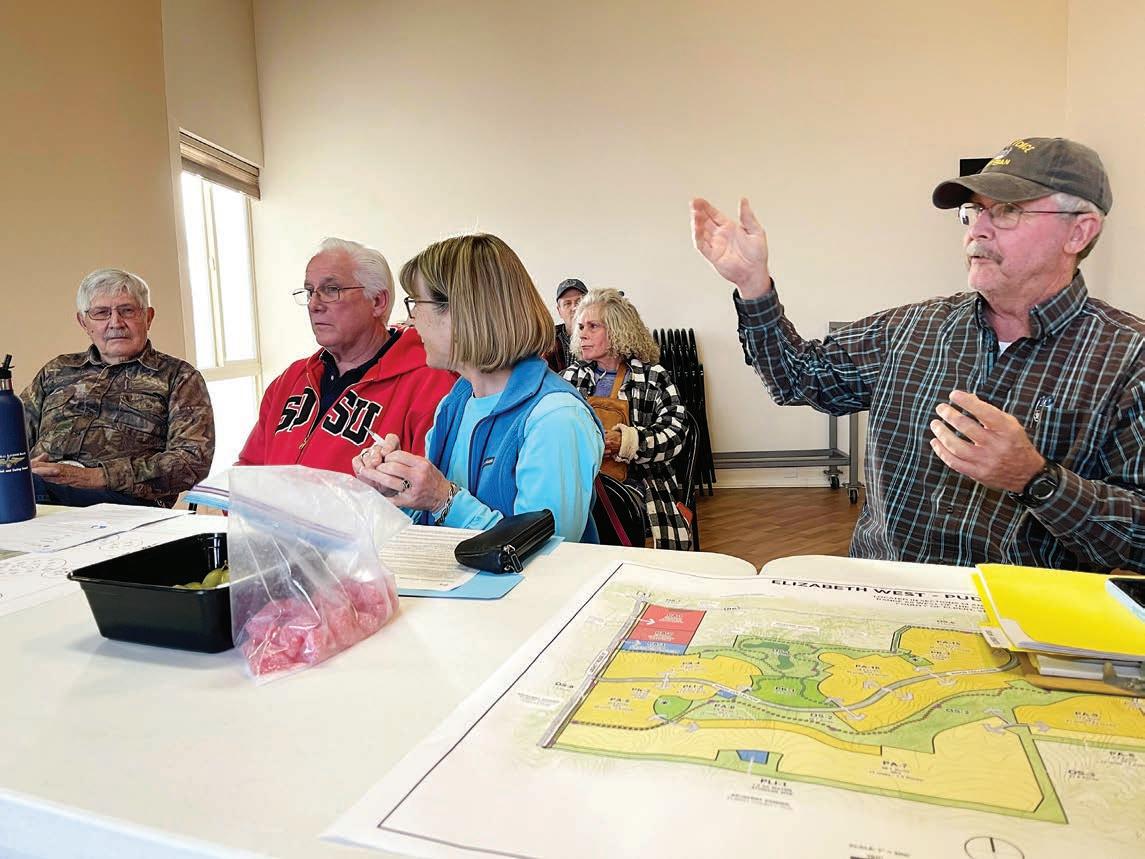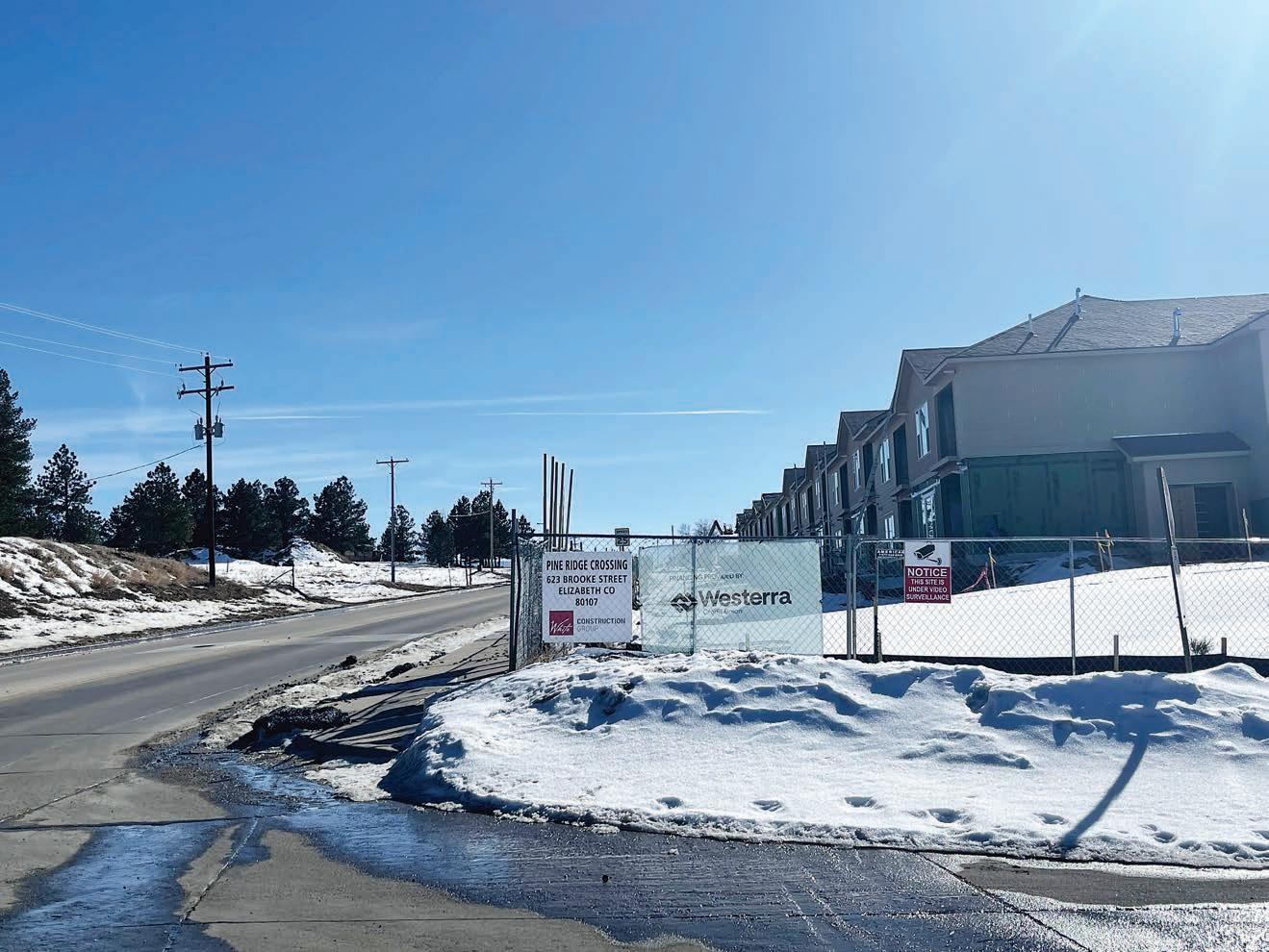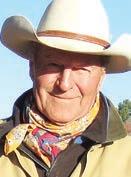Former Elbert County Commissioner Robert Rowland, right, speaks out at an anti-development meeting last November about his concerns regarding water availability in the county.
 PHOTO BY CHANCY J. GATLIN-ANDERSON
PHOTO BY CHANCY J. GATLIN-ANDERSON

Former Elbert County Commissioner Robert Rowland, right, speaks out at an anti-development meeting last November about his concerns regarding water availability in the county.
 PHOTO BY CHANCY J. GATLIN-ANDERSON
PHOTO BY CHANCY J. GATLIN-ANDERSON


Water availability has been a concern for many Colorado residents across time. Now, with the
INSIDE: CALENDAR: PAGE 11 | VOICES: PAGE 12
Elbert County is growing, and with growth comes an increased demand for adequate housing.
A June 2022 article in e Colorado Sun described Elbert County as Colorado’s only Eastern Plains county to see increased growth. is is likely due to its proximity to the Denver metroplex.

According to the article, “population along Colorado’s Front Range, including Denver, Colorado Springs and Fort Collins, grew by about 17% in the last decade. e number of residents on the Eastern Plains, meanwhile, remained basically unchanged. In many plains counties, the population dropped. Elbert County, the westernmost of the plains counties that includes the town of Elizabeth and borders the south Denver suburbs, was the outlier with a 13% increase in residents.”
state’s growing population and development in and around the Denver metro area, the threat of running out of water has residents concerned.
“I’m concerned about the water that we have,” said former Elbert County Commissioner Robert Rowland at a local anti-development meeting in November of last year.
“If the water is there, bring on the development. Growth will come.
It’s inevitable, but I want to see
science, real concrete data that we have enough water to sustain a development like this. We need a groundwater study. Water should be the number one consideration when it comes to development.”
To help educate residents on the current state of water in Elizabeth and surrounding areas, the Town of Elizabeth will be holding a free seminar called “Water 101.”
e Elbert County Department of Economic Development released a Housing Needs Assessment in November 2022, aimed at determining the future need for housing in the area.


“We knew Elbert County had limited housing variety and the Housing Needs Assessment (HNA) that we completed last year con rmed it. 94% of Elbert County’s housing inventory is detached single family
It’s the season for Girl Scout treats P10

COOKIE ... COOKIE ...




homes,” said Elbert County Director of Economic Development Eric Dettenrieder in an email correspondence from Feb. 6. “When looking at future housing projections, the HNA details that Elbert County will need approximately 3,050 more units over the next 10 years. It is anticipated that workforce housing will constitute 63% of that total. With rising housing costs, it is believed the average worker in Elbert County earning







$52K a year can a ord 50% of the rental units and less than 10% of the single family homes.”



To help ful ll the growing demand, Elbert County is expanding its housing availability and diversifying the variety of housing options for future and current residents, including apartments.


e new Pine Ridge Apartments in Elizabeth are already looking to expand due to high demand. e apartments are located o South Elizabeth Street next to Big R and the Elizabeth branch of the Pines

& Plains Libraries. e Pine Ridge Apartments are not income-restricted and are available to all.
e site development plan was approved in 2019 by the Town of Elizabeth Board of Trustees. Construction of the rst two buildings, consisting of 32 units total, is anticipated to be nished and available early spring 2023.

e project developers have submitted an application to the Town of Elizabeth seeking to add an additional 16 garden-level units. e developers are seeking the increase due to high demand for housing in and around Elizabeth. ey hope that the garden-level units will create more options for people needing accessibility (including seniors).
Elizabeth resident Patsy Moore Weskamp is looking for housing options for her aging mother. She thinks apartment living will t their family’s needs. In a phone interview from Feb. 6, Weskamp expressed the desire to have her mother move into the Pine Ridge Apartments to be closer to family and to save on general living costs.
“I’m solely responsible for my mother and it would be nice to have her close by in case of an emergency,” commented Weskamp. “She can spend more time with her granddaughter who is in rst grade here in Elizabeth.”
For Weskamp, paying to house her mother has become una ordable. Currently, Weskamp’s mother lives at Morning Star Senior Living in Parker and pays $4,900 per month for her 750-square-foot apartment.
“We’ve looked into options as far as building on our property, but that is also prohibitively expensive,” said Weskamp. “Having options is important to the people of Elizabeth. For both the demographic of people moving into the area and for longtime residents looking to downsize and retire.”
ough not designated senior housing, the Pine Ridge Apartments will serve some of Elbert County’s retired population.
“It is interesting to note that the population of residents over 55 years
or older has more than doubled since 2000 in Elbert County. Over 1,000 non-workforce households (retired/seniors) will need to be added to the housing inventory over the next 10 years and 57% of those will be single person households,” explained Dettenrieder. “It is clear that alternative type and price housing options are needed in the county to meet demand.”
“While we expected this project would serve seniors in the area, I was still surprised at how many phone calls I received from seniors in need of this type of housing,” commented Grace Erickson of Providence Consulting LLC in a phone interview from Feb. 3. “I think it’s wonderful that there will soon be a rentable product in Elbert County to serve the needs of these folks and others.”
e public hearings with the Town of Elizabeth for the approval of the 16 additional garden-level units are scheduled for 6:30 p.m. on Feb. 21 (Planning Commission) and 7 p.m. on March 14 (Board of Trustees). Both hearings are at the Town Hall located at 151 S. Banner St. in Elizabeth.
“ e additional proposed units are needed to make the project more economically feasible and lower the cost of monthly rent as to keep the rents at or near market,” said Grace Erickson of Providence Consulting LLC, development consultant for Pine Ridge. “ e additional units will also help to meet some of the demand from residents in need of rentable housing which has been exponential in regard to this development.”
e Pine Ridge Apartments website is under construction but will be updated soon. It can be found at liveatpineridge.com.
To view the 2022 Elbert County Housing Needs Assessment, visit tinyurl.com/ECHNA2022.
To read the referenced Colorado Sun article on the fastest growing and shrinking counties in Colorado, visit tinyurl.com/CSunShrink.
To learn more about plans for Elbert County’s future economic development, visit elbertcountyworks. com.
Questions on Pine Ridge Apartments can be directed to Providence Consulting LLC at 719-207-2995.
Douglas County offices will be closed Monday, Feb. 20, 2023. Many services are available at DoItOnlineDouglas.com

Help is available at ImatterColorado.org. Take a brief assessment to find out if your child is eligible for free counseling. For additional resources in and around Douglas County, visit douglas.co.us and search Mental Health Resources

If you need immediate support, call Colorado Crisis Services at 1.844.493.TALK(8255) or text TALK to 38255. If you are experiencing a life-threatening emergency, call 911.

Do you know a Douglas County teenager, between the ages of 13 and 19, who has overcome adversity and created positive change in their lives, as well as the lives of others? Nominate them for a 2023 Douglas County Outstanding Youth Award by March 3. Visit douglas.co.us and search Youth Awards
Our commitment to open and transparent government includes online posting of information about public meetings at which the business of government is conducted. To view public meeting agendas, participate in-person or remotely, or watch select meetings via live stream, visit douglas.co.us and search for Business Meetings / Public Hearings.
 BY JESSE PAUL THE COLORADO SUN
BY JESSE PAUL THE COLORADO SUN
John Hickenlooper has been quietly convening fellow U.S. senators from six other Colorado River Basin states over the past year in an e ort to assist in the increasingly frantic conservation negotiations around the parched and overtaxed waterway that some 40 million people in the Southwest rely upon.
Hickenlooper, a Democrat, sees the informal, bipartisan caucus as a way to mediate interstate disagreements over how the river should be managed — and who should have to use less of its water — in the hope of preventing federal intervention. While states’ governors may not meet on a regular basis, senators from across the river basin are frequently together in Washington, D.C.
“ e idea here is that we’re looking at how to use more carrot and less stick,” he said. “ e key here is the
federal government is not the best one to force a deal.
e best solution is going to be a solution that all seven states sign o on.”
e group of senators has been meeting every few weeks to discuss Colorado River Basin issues. e gatherings have become more frequent amid Biden administration deadlines for basin states to come to a water conservation agreement that prevents Lake Mead and Lake Powell levels from dropping too low.
e reservoirs are already at historically low levels, yet the negotiation deadlines have come and passed without a deal.
“I think the senators can provide additional information that maybe the states don’t all have,” Hickenlooper said, “and make sure that everyone is working together.”

Hickenlooper didn’t provide details on what the caucus has discussed, but he said the group has met with Bureau of Reclamation Commissioner Camille Touton, who warned that 4 million acre-feet in existing water use must be pared back.

“We’re all really hearing what priorities and speci c issues are with each state and with the water users in each state,” he said. “As long as we understand that and are working from the same set of facts, we’re probably going to come up with a much better solution than
if things degenerate into lawsuits.”
Hickenlooper said the caucus is looking to formalize itself with a chair and subchairs from the upper and lower Colorado River Basin.
is story is from e Colora-


do Sun, a journalist-owned news outlet based in Denver and covering the state. For more, and to support e Colorado Sun, visit coloradosun.com. e Colorado Sun is a partner in the Colorado News Conservancy, owner of Colorado Community Media.

e seminar will take place at 6:30 p.m. on Tuesday, March 7. e event will be held at the Elizabeth Town Hall and will take place ahead of the regularly scheduled meeting of the Town of Elizabeth Planning Commission.








e meeting is designed to provide a basic understanding of Colorado water law and speci c provisions within the Town of Elizabeth. Representatives of the town’s “Water Team” will be presenting the information.








Anticipated discussions will include an introduction to Colorado water law, the town’s own water holdings, demands on water in the area, the implementation of the 300-year water rule, and related matters.












ough the schedule for the seminar has not yet been set, anticipated speakers include the town’s water attorney David Kueter with Holsinger Law LLC, Robert Anderson of JVA Consulting Engineers, and Mark Palumbo or Matt Seitz with HRS Water Consultants.










Attendees with will have the opportunity to ask questions and voice their concerns.


As state leaders prepare to launch Colorado’s free preschool program next fall, some educators and advocates fear young children with disabilities will lose out under the new system.
ey say 3-year-olds could be rejected for a spot and 4-year-olds could receive less preschool than they’re due because of the narrow way the state asks about children with disabilities on its preschool application form.
In addition, school district ocials say that unanswered questions about special education funding and confusion over how two state agencies will work together on the preschool program are a troubling sign for a major new program that will start in a matter of months.
While many early childhood advocates and providers have praised Colorado’s plan to signi cantly expand publicly funded preschool, there’s ongoing concern that the rollout is being rushed.
“I think the [Colorado Department of Early Childhood] was pushed into something very quickly,” said Callan

“I support and appreciate the idea of universal preschool programming,” said Pam Bisceglia, executive director of Advocacy Denver, an advocacy group for people with disabilities. “My question is whether those programs are going to be lled with children of parents who enjoy privilege.”

Preschool application poses challenges
Children with disabilities are supposed to get priority for 10 hours a week of class time at age 3 and 30 hours a week at 4.
But Heather Hanson, whose 9-year-old son was diagnosed with a speech delay as a toddler and later with dyslexia, believes the state’s new preschool program will make it even harder than it is now for young children with disabilities to get the help they need.
e universal preschool application is part of the reason. It asks parents if their child has “an active Individualized Education Program” — a fancy name for a federally required learning plan for students 3 and older with disabilities.
But many children don’t get such plans until after they enroll in school. A young child with a delay may not even have been evaluated or received a diagnosis. Even when children are identi ed as toddlers, their plan has a di erent name and acronym than the one on the preschool application.
Hanson, who served on a special education subcommittee during the universal preschool planning process, called the wording on the application “horrible” and “discriminatory.”
“All of those really big words


Colorado Consortium of Directors of want to miss children because of an





classes through thepreschool special education program. Another group factors — such as language delays or poor social skills — qualify for a state preschool program that will end after this school year.

Kids in that second group don’t have to have a diagnosis or special learning plan to qualify for free preschool.
But under the new universal preschool program, the state will use fewer risk factors to decide who can attend for free at age 3 and get extra hours at age 4. One of them is the Individualized Education Program. e others consider whether the child is homeless, an English learner, in foster care, or comes from a lower-income family.
Hundley said there’s no way for a parent who suspects their child might have a disability to ag their concern when applying for universal preschool.
O cials from the early childhood department and education department said in an email that state law requires the Individualized Education Program criteria on the universal preschool application. Hundley said it’s unlikely the law would disallow additional criteria that might help capture students with potential disabilities.

Several advocates said the wording should be simpler and more general: “Do you think your child could use some extra help?” or “Do you have concerns about your child’s speech or behavior?
Laurie Noblitt, director of elementary and early learning for the Fountain-Fort Carson district, said her district has elded calls from parents whose 3-year-old children
AGES
Fears flare that free preschool could shortchange kids with learning delays

don’t qualify for free preschool according to the application system.

ey say things like, “I’m really worried about my child’s language, they’re only speaking in one- or twoword phrases,” she said.

In such cases, Noblitt said, the district helps get the child evaluated and into preschool, but she worries about the families who don’t make that phone call.
ree-year-olds whose parents don’t know how to navigate the system stand to lose out on free preschool altogether and 4-yearolds with disabilities could get just 15 hours a week, half what they’re supposed to.
Hanson said those extra hours can make a big di erence since students with disabilities sometimes need double or triple the repetition and
exposure to classroom learning compared with their typically developing peers.
e low number of hours o ered to 3-year-olds also puts a burden on parents, said Elisa Aucancela, executive director of El Grupo Vida, a nonpro t that supports Hispanic families who have children with disabilities.

Her brother, who has a 3-year-old daughter with a disability, is “still struggling due to the part-time [hours] for 3-year-olds” she said.
“It’s a really di cult challenge for some families because what are they going to do for the other half of the time when they need to work?”
Special education funding in question

Several school district leaders worry about how the state is handling $33 million that used to go to school districts to help cover preschool special education costs. ey fear the money — which amounts to $36,000 a year in small districts like
Englewood and up to $4 million in large districts — now will be mixed into the general universal preschool funding pot, and won’t be set aside for services for students with disabilities.
If that happens, districts will have to use local dollars to cover lost state money since they’re legally required to cover special education services. Hundley said that means funding for sta like psychologists and speech therapists who provide mandated services to students with disabilities gets diverted from other district priorities.
Even thoughstate funding for special education has increased in recent years, districts still cover about two-thirds of those costs out of their local budgets.
State o cials estimate they’ll spend at least $33 million — and possibly more — on what they call “general education” seats for students with disabilities. But Hundley said school districts want the state
to direct that money speci cally to special education services, which is how it has been used in the past.



Beyond money, the uncertainty about funding raises questions about how two state agencies — the early childhood department and the education department — are divvying up overlapping responsibilities.
In response to Chalkbeat’s questions about funding for preschoolers with disabilities, the education department rst referred questions to the early childhood department. Afterthe two agencies signed an agreement this week outlining how they’d work together, the early childhood department referred questions to the education department. On Friday, the two departments released emailed answers together. Neither granted an interview.
Ann Schimke is a senior reporter at Chalkbeat, covering early childhood issues and early literacy. Contact Ann at aschimke@chalkbeat.org.


e Colorado Department of Regulatory Agencies recently warned state lawmakers that it is unprepared for its assigned job of implementing the state’s new, second-in-the-nation legal “magic mushroom” industry, which voters approved in November.

e department — which normally oversees sectors like insurance and banking — is tasked with quickly adopting a regulatory structure under which psychedelic mushrooms can be legally consumed by people 21 and older at licensed facilities. e facilities are set to open as soon as late 2024.
DORA will also be responsible for writing regulations governing the cultivation and manufacturing of psychedelic mushrooms, as well as protecting consumers, developing public education campaigns and making recommendations to the legislature about how to shape the industry.

ere’s just one problem: DORA says it has no idea what it’s doing when it comes to psilocybin, the hallucination-inducing compound derived from psychedelic mushrooms.
“ is is an area completely outside the scope of any existing expertise or regulatory history within the department,” DORA wrote in a budget document submitted to the legislature’s Joint Budget Committee. “ is is unlike anything else the department regulates. e department has no resources or expertise to begin implementation of this expansive new program involving substances with agricultural, controlled substance, chemical/ scienti c and facility issues.”
Proposition 122, which legalized
magic mushrooms, passed by nearly 8 percentage points. e measure was unique in that it speci cally charged DORA with rolling out the psilocybin industry, as opposed to letting the state gure out for itself which of its agencies should be responsible for regulating magic mushrooms. And it doesn’t appear Proposition 122’s proponents reached out to DORA to see if they could handle the responsibility.
“Did they come sit down and say do you want to take this? I don’t think so,” said Katie O’Donnell, a spokeswoman for DORA. “It could have gone in a lot of places. It doesn’t t perfectly in any of them.”
(Patty Salazar, who leads DORA, declined an interview request as her agency works to determine who will take on the psilocybin assignment.)
e Colorado Department of Revenue, for instance, regulates the cannabis industry. Hemp is handled by the Department of Agriculture.
DORA? It houses the Colorado Civil Rights Division and Broadband Deployment O ce. To put it simply: DORA isn’t synonymous with psychedelics.
“It just doesn’t t in the mold of what we regulate,” said O’Donnell, who explained that DORA is preliminarily planning to handle regulations for psilocybin and the other plants through its Division of Professions and Occupations.
Tasia Poinsatte, who leads the Healing Advocacy Fund, an oshoot of the group that funded the passage of Proposition 122, said supporters of the measure thought DORA was an appropriate place to regulate Colorado’s new psychedelic mushrooms endeavor because of its licensure work.
“Proposition 122 was designed to provide breakthrough therapies




to Coloradans for mental health and wellness,” Poinsatte said. “At the heart of this new regulated program are the licensed facilitators who supervise the preparation sessions, the natural medicine administration session, and the integration sessions. We believe it’s appropriate for the agency that regulates other health professions, such as therapists, addiction specialists and nurses, to also regulate this new profession of licensed facilitators.”
Still, Poinsatte said she recognizes DORA may need help creating a “program that works for all Coloradoans and is a model for the rest of the country.” Oregon is the only other state where psychedelic mushrooms are legal, and that only happened Jan. 1.
Proposition 122 allows people 21 and older in Colorado to grow and share psychedelic mushrooms. Sales, however, are not allowed.
Where DORA comes in will be the state-regulated centers OK’d by Proposition 122, where people will be able to make appointments to consume psilocybin.
Gov. Jared Polis last month appointed 15 people to serve on the state’s “Natural Medicine Advisory Board,” which is tasked with advis-
Colorado Community Media welcomes letters to the editor. Please note the following rules:
• Email your letter to letters@coloradocommunitymedia.com. Do not send via postal mail. Put the words “letter to the editor” in the email subject line.
• Submit your letter by 5 p.m. on Wednesday in order to have it considered for publication in the following week’s newspaper.
• Letters must be no longer than 400 words.
• Letters should be exclusively submitted to Colorado Community Media and should not submitted to other outlets or previously posted on websites or social media. Submitted letters become the property of CCM and should not be republished elsewhere.
• Letters advocating for a political candidate should focus on that candidate’s qualifications for o ce. We cannot publish letters that contain unverified negative information about a candidate’s opponent. Letters advocating for or against a political candidate or ballot issue will not be published within 12 days of an election.
ing DORA on implementing the regulations. 5280 magazine reported there were more than 200 people who applied to be on the board.
But DORA says it still needs more help.
In its budget request to the legislature, DORA said it wants to spend $700,000 this year and next to “contract resources and expertise” to get its trip down the rabbit hole going. It says the speed at which it’s expected to implement rules is unprecedented, and it’s still guring out the fee structure for legal-use facilities under which it will fund its work.
And once DORA gets its psychedelic mushroom regulations squared away, the work may be just beginning.
Proposition 122 gives the Natural Medicine Advisory Board the option to similarly legalize and regulate a number of other naturally derived psychedelics, including dimethyltryptamine (known as DMT), ibogaine and mescaline, which is found in the San Pedro cactus.
is story is from e Colorado Sun, a journalist-owned news outlet based in Denver and covering the state. For more, and to support e Colorado Sun, visit coloradosun. com. e Colorado Sun is a partner in the Colorado News Conservancy, owner of Colorado Community Media.
• Publication of any given letter is at our discretion. Letters are published as space is available.
• We will edit letters for clarity, grammar, punctuation and length and write headlines (titles) for letters at our discretion.
• Please don’t send us more than one letter per month. First priority for publication will be given to writers who have not submitted letters to us recently.
• Submit your letter in a Word document or in the body of an email. No PDFs or Google Docs, please.
• Include your full name, address and phone number. We will publish only your name and city or town of residence, but all of the information requested is needed for us to verify you are who you say you are.
• Letters will be considered only from people living in Colorado Community Media’s circulation area in Adams, Arapahoe, Clear Creek, Denver, Douglas, Elbert, Je erson and Weld counties.

• Do not use all caps, italics or bold text.
• Keep it polite: No name calling or “mudslinging.”
The Colorado Sun is a journalist-owned, award-winning news outlet that strives to cover all of Colorado so that our state — our community — can better understand itself.
In this way, The Sun contributes to a more vibrant, informed and whole Colorado.
The Sun, launched in 2018, is committed to fact-based, in-depth and nonpartisan journalism. It covers everything
from politics and culture to the outdoor industry and education. Now, The Colorado Sun co-owns this and other Colorado Community Media newspapers as a partner in the Colorado News Conservancy. The Sun is CCM’s partner for statewide news.
For Colorado Sun stories, opinions and more, and to support The Sun’s misssion as a member or subscriber, visit coloradosun.com.
 BY CHRISTY STEADMAN CSTEADMAN@COLORADOCOMMUNITYMEDIA.COM
BY CHRISTY STEADMAN CSTEADMAN@COLORADOCOMMUNITYMEDIA.COM

e rst year that Denver Girl Scout Bianca Morris started selling Girl Scout Cookies, she was hesitant to stand at a grocery store booth because she had yet not built up her con dence with customer interactions.
Today, booth sales are her favorite part of the scouts’ annual cookie business. She enjoys joyful conversations with customers as she rings up sales, and gracefully accepts the “no, thank yous.”
Morris, who is 13 and in the eighth grade, has been in Girl Scouts since she was in the third grade. After muddling through the COVID-19 pandemic for the past couple of years, this year she is eager for more in-person encounters.
“It brings the community together,” Morris said of cookie season. “It’s something you can look forward to every year.”
ies — but the program is about so much more than cookies,” said Leanna Clark, CEO of Girl Scouts of Colorado, in a news release. “When you purchase cookies, you are helping girls power their Girl Scout leadership experience and you’re supporting female entrepreneurs.”
Cookie season focuses on ve lifelong skills: goal setting, decision making, money management, people skills and business ethics.
“I think the most valuable aspect of the program is the way the skills build upon each other and grow with the girls,” said Robin Morris, Bianca’s mom. “As a Brownie, the girls were developing their people skills — getting out into the community and talking to people. Now, as teens they are using management skills as they begin working at their rst jobs and saving towards college.”
1. Booth sales: There is a mobile app to help find the Girl Scout cookie booths, or text COOKIES to 59618. To use the Cookie Finder online, visit girlscoutsofcolorado.org, and select Find Cookies. Enter your zip code in the Cookie Finder, and a new window will provide you with a list of dates, times and locations of a local Girl Scout cookie booth.
2. Digital Cookie: If you know a Girl Scout, this might be the most direct way to get your cookies. Your Girl Scout might send you an invite to purchase cookies from her Digital Cookie site, but you can also ask her for her Digital Cookie link. Through Digital Cookie, you pay online and cookies are shipped.
Denver Girl Scout, is looking forward to selling cookies again this year — particularly the booth sales, because that’s when she gets to interact with the community. Cookie season runs Feb. 5-March 12 this year.

Cookie sales run from Feb. 5 to March 12 and nine di erent kinds of cookies are going by the boxful: Adventurefuls, in Mints, Samoas, Tagalongs, Trefoils, Dos-Si-Dos and Lemon-Ups, S’mores and To eetastic. e cookies sell for $5 or $6 a box.
A new thin, chocolate-dipped cookie, Raspberry Rally, won’t be on Morris’ counter, but available as an online-exclusive. e Girl Scouts’ Digital Cookie platforms will o er it starting Feb. 27.
“Everyone loves Girl Scout Cook-






Girl Scouts begin their journey as Daisies in kindergarten and rst grade. ey become Brownies in the second and third grade, then Juniors. Bianca Morris is currently a Cadette. Her next step will be a Senior as a ninth- and 10th-grader before she becomes an Ambassador in her junior and senior year of high school.
“Eating cookies is always a perk of cookie season,” Bianca Morris said.
But it’s the sense of accomplishment that is most rewarding.
rough the years, Bianca Morris has learned many skills — both as a Girl Scout and through cookie sales — that have carried through to di erent aspects of her life.
“Bianca’s con dence has soared as a result,” Robin Morris said.
She pointed to a recent example

that her daughter experienced at school when one of the clubs Bianca Morris is part of was raising funds to donate to a charity.
“ ey were selling baked goods and the table was overrun by hungry middle schoolers anxious to buy,” Robin Morris said. “Bianca quickly jumped behind the counter and told her teachers she was experienced with cash handling from Girl Scouts and could help the teachers run the cash box.”
Cookie sales have been a staple for the scouts for more than 100 years. e tradition started in 1917.
“I think every person may have some connection to selling, buying or eating Girl Scout Cookies,” Robin Morris said. “Today’s Girl Scouts are excited to continue to create that experience for others as they build a foundation of practical life skills.”

Thu 2/23
Art: Hands-On Introduction to DSLR Photography (16+yrs)
@ 2am Feb 23rd - Mar 22nd









PACE Center, 20000 Pikes Peak Avenue, Parker
Sun 2/26
Tue 2/28
Stephen Pearcy

@ 8pm
Wild Goose Saloon, 11160 S Pikes Peak Dr, Parker
Fri 2/24
CW & Twenty Hands High @ 8pm

The Englewood Tavern, 4386 S Broadway, Englewood
Phat Daddy @ 8pm
Q's Pub and Grill, 10133 W Chat�eld Ave, Littleton
Koyo @ 8pm Gothic Theatre, 3263 S Broadway, Engle‐wood
Friday Movie - The Good House @ 9pm Heather Gardens Clubhouse, 2888 S. Heather Gardens Way, Aurora
Binomio De Oro De America en Concierto @ 10pm / $50-$80
Stampede, 2430 South Havana, Aurora
Fleming Mansion Walkthrough (for permit holders only) @ 10pm Fleming Mansion, 1510 S. Grant St., Den‐ver. 720-913-0654
Sat 2/25
Highlands Ranch 5k/10k @ 9:30am / $33-$48




9651 S Quebec St, Highlands Her‐itage Regional Park, Highlands Ranch
American Authors @ 8pm
Gothic Theatre, 3263 S Broadway, Englewood
Wed 3/01
Theater: Parker on Broadway (1015yrs) @ 12:30am
Mar 1st - May 9th
PACE Center, 20000 Pikes Peak Ave., Parker
Kids’ Zone: Dino Stomp (3-6 yrs) W/S23 @ 5pm
Mar 1st - Mar 29th
Parker Recreation Center, 17301 E Lincoln Ave., Parker
Declutter Your Home @ 6pm
Mar 1st - Mar 29th
Dan Bremnes: Marriage Date Night @ 6:30pm

Authentic Life Church, 6500 W Coal Mine Ave, Littleton
Bayside "Just Like Home" Tour (with I Am The Avalanche + Koyo)


@ 7pm Gothic Theatre, 3263 S Broadway, Englewood
Trouble Bound: AMERICANA CIRCUS @ 7pm


Moe's Original BBQ, 3295 S Broadway, Englewood
JD Eicher @ 7pm
Twenty Mile House Concerts, 11875 Cattle Lane, Parker
Banda Los Recoditos @ 9pm / $50

Stampede, 2430 South Havana, Aurora
Baking Soda Volcano @ 11am
Sinners & Saints, 221 Perry St, Castle Rock
Heather Gardens Clubhouse, 2888 S. Heather Gardens Way, Aurora
Mad Caddies @ 8pm Gothic Theatre, 3263 South Broadway, En‐glewood
DJ Rockstar Aaron: Forbidden Bingo at 'Bout Time Pub & Grub @ 8pm
Bout Time Pub & Grub, 3580 S Platte River Dr A, Sheridan
Thu 3/02
Denver Concert Band: A European Sojourn @ 2pm / $22

Lone Tree Arts Center, 10075 Commons Street, Lone Tree. Info@ DenverConcertBand.org, 720-5091000

Mon 2/27
Modern Swing Mondays @ 6pm / $10 Stampede, 2430 South Havana, Aurora
Volleyball: Youth - Ages 10 to 12Spring 2023 @ 11pm
Feb 27th - May 6th Parker Fieldhouse, 18700 E Plaza Dr, Parker
Shallow Side @ 8pm
Wild Goose Saloon, Parker
HE$H @ 9pm

We are fully emerged into February, the month each year when medical professionals and healthcare organizations try to bring more awareness to heart health. While it should be a year-round priority for everyone, February is speci cally aimed at putting a focus on cardiovascular health.
I am extremely proud of my name. To be called “ elma” comes with some pride every time I hear it. You see, I was named after my grandmother who died months before I was born. As I am often told, my grandmother wanted a granddaughter so badly.
I never go to meet her. So, I got the next best thing — her name.
My grandmother was 50 years old when she died of a heart attack. My mom’s side of the family is a mess when it comes to genetic health, but the heart is the biggest concern.
My mom was afraid to turn 50 because of heart issues that owed through her family. When 50 came and went — she was relieved, but she de nitely keeps up with heart testing and taking preventative measures.
For me, now in my 40s, I tend to ask my doctor a lot of questions about my heart. I share a name with a woman I never met because in the 1970s there was a lot less information available to people about heart health.
ere really wasn’t a month aimed speci cally at raising hearth health awareness.
A heart problem can be sneaky, since symptoms can present di erently in every individual. Someone with heart disease or heart failure may not experience the same symptoms as another person with the same condition.
While breast cancer tends to get a lot of attention in terms of women’s health and preventative measures — heart disease is actually a bigger culprit each year.
According to the CDC, despite e orts to increase awareness, only 56% of women recognized heart disease as the top killer. As the leading cause of death for women in the U.S., heart disease was responsible for 314,186 women dying in 2020. at equates to 1 in every 5 female deaths.
For personal reasons I write about women, but in reality, heart disease has a huge e ect on the entire U.S. population.
According to the CDC, one person dies every 34 seconds in the U.S. of cardiovascular disease. In total, 697,000 Americans died in 2020 of heart disease. at equates to 1 in every 5 deaths.
According to the CDC, the term heart disease refers to several types of heart conditions because it all goes toward issues a ecting the blood ow around the heart. Decreased blood ow, for instance, can cause a heart attack.
Sometimes heart disease can go completely unnoticed and undiagnosed until a person su ers from a heart attack, heart failure or arrythmia.
Instead of waiting for something major to happen, health o cials continue to stress the need to be proactive in healthcare, meaning taking preventative measures and tests as directed each year.
For more information on issues of the heart, visit the American Heart Association website at heart.org.
elma Grimes is the south metro editor for Colorado Community Media.

LINDA SHAPLEY Publisher lshapley@coloradocommunitymedia.com
MICHAEL DE YOANNA Editor-in-Chief michael@coloradocommunitymedia.com
750 W. Hampden Ave., Suite 225 Englewood, CO 80110
Phone: 303-566-4100
Web: ElbertCountyNews.net

To subscribe call 303-566-4100
As a partner and potential sales channel to the enterprise selling team, they were faced with a decision to make about an interaction they had with a new account executive they had just started working with. ere was a lack of follow-up on the account executive’s part and the partner was torn between letting the young account executive’s boss know, or not.

Ultimately, he decided to call their boss because they wanted to provide a coaching opportunity for the young new hire.
e leader was grateful and said, “ ank you as I cannot x something that I do not know is broken, and I cannot manage what I do not know.”
ere is so much sensitivity around what we can say and what we cannot or should not say. We fear that it may not be our place to say anything at all, after all we may become the one where others choose to point the nger of blame. We would rather keep our mouth shut and let the next person who receives bad service or experiences a problem be the one to share their concerns. Maybe they are braver than we are in those moments.
e question becomes this, wouldn’t we want to know if something that we, or someone in our family, circle of friends, or company was doing something, or had done something, that wasn’t right and could po-
LINDSAY NICOLETTI Operations/ Circulation Manager lnicoletti@coloradocommunitymedia.com
ERIN ADDENBROOKE Marketing Consultant eaddenbrooke@coloradocommunitymedia.com






tentially be harmful to others or to our family or business? Most of us would answer the same way, of course we would.
In the case above, the leader did use it as a coaching moment and the young account executive embraced the feedback and became determined to make a change in his response times and doing what they said they would do when they said they would do it.
Another friend I know stopped going to the same co ee shop they had been stopping by every morning for years. When I asked them why, they said that the shop had started serving co ee that wasn’t as hot as it should be. I asked them if they let the manager know. ey shook their head and said, “No.” is was a simple or minor issue that, if the manager had known or been told, could have been easily resolved.
We know parents who have approached the o cials of the school where their child was being bullied. e o cials were given the opportunity to x what was broken. ey now knew what they had to manage, yet they refused to take action. e nal outcome was that the child was transferred to another school and thankfully, was met with a new set of friends who they became very close with, enjoying a wonderful and safe high school experience.
It’s no di erent at home or in any relationship. If we do not know what is broken, we cannot manage or x what we do not know. We have to provide others a safe environment
Columnists & Guest Commentaries
Columnist opinions are not necessarily those of the Elbert County News.

We welcome letters to the editor. Please include your full name, address and the best number to reach you by telephone.
(USPS
THELMA GRIMES South Metro Editor tgrimes@coloradocommunitymedia.com
SCOTT GILBERT Editor sgilbert@coloradocommunitymedia.com
AUDREY BROOKS Business Manager abrooks@coloradocommunitymedia.com
ERIN FRANKS Production Manager efranks@coloradocommunitymedia.com
Email letters to letters@coloradocommunitymedia.com
Deadline Wed. for the following week’s paper.

We cannot manage what we do
We survived 2022, but will 2023 be better? One could hope but some of the same economic issues still haunt us. erefore, volatile nancial markets may continue for a bit.
Many investors may recall a mantra, “As January goes, so goes the year.” is is referring to how well the stock market performs the rst month of the year and could be an indicator for the entire year’s returns. Bill Greiner, CFA, chief economist for Mariner Wealth Advisors, states this is correct 72% of the time. at is good news since January was a positive month for the S&P 500.


to share what they see as a problem or an area that can be improved, and then be vulnerable enough to acknowledge that it can be better and then take the steps necessary to x the problem.

Two of the most important ingredients to any successful relationship, husband-wife, parent-child, teacher-student, employer-employee, company-customer, or any other relationship are communication
Colorado Community Media welcomes letters to the editor. Please note the following rules:
• Email your letter to letters@coloradocommunitymedia.com. Do not send via postal mail. Put the words “letter to the editor” in the email subject line.
• Submit your letter by 5 p.m. on Wednesday in order to have it considered for publication in the following week’s newspaper.
• Letters must be no longer than 400 words.
• Letters should be exclusively submitted to Colorado Community Media and should not submitted to other outlets or previously posted on websites or social media. Submitted letters become the property of CCM and should not be republished elsewhere.
• Letters advocating for a political candidate should focus on that candidate’s qualifications for o ce. We cannot publish letters that contain unverified negative information about a candidate’s opponent. Letters advocating for or against a political candidate or ballot issue will not be published within 12 days of an election.
Many issues still linger though, such as an increasing probability of a recession. One reason is the Federal Reserve Board’s indication to continue increasing interest rates to help curb in ation. We may also see corporate earnings begin to wane after holding up well last year. is could be due to higher costs of borrowing along with the labor shortage.
Consumers are tired. Tired of winter, tired of economic uncertainty and in ation. Business owners are drained from trying to nd workers, rising lease rates and higher cost of goods. Investors are weary of stock market declines and interest rate increases. e war in Ukraine continues. COVID seems to have reappeared. is is when people are most pessimistic. And that creates opportunity.
While everyone is crying in their soup, you could be taking advan-



and trust. And when we can honestly and openly share with others what needs to change or be managed better, most times we will be seen as being helpful as again, none of us can x or manage what we do not know is broken or a problem in the rst place.
How about you? Do you feel safe and comfortable sharing with your boss, partner, co-worker or the manager of a store where you frequently shop what is broken or needs to be managed better or di erently? Or would you rather someone else take that responsibility? I would love to hear your story
• Publication of any given letter is at our discretion. Letters are published as space is available.





• We will edit letters for clarity, grammar, punctuation and length and write headlines (titles) for letters at our discretion.
• Please don’t send us more than one letter per month. First priority for publication will be given to writers who have not submitted letters to us recently.
• Submit your letter in a Word document or in the body of an email. No PDFs or Google Docs, please.
• Include your full name, address and phone number. We will publish only your name and city or town of residence, but all of the information requested is needed for us to verify you are who you say you are.
• Letters will be considered only from people living in Colorado Community Media’s circulation area in Adams, Arapahoe, Clear Creek, Denver, Douglas, Elbert, Je erson and Weld counties.

• Do not use all caps, italics or bold text.

• Keep it polite: No name calling or “mudslinging.”






The Colorado Sun is a journalist-owned, award-winning news outlet that strives to cover all of Colorado so that our state — our community — can better understand itself.
In this way, The Sun contributes to a more vibrant, informed and whole Colorado.
The Sun, launched in 2018, is committed to fact-based, in-depth and nonpartisan journalism. It covers everything
from politics and culture to the outdoor industry and education.



Now, The Colorado Sun co-owns this and other Colorado Community Media newspapers as a partner in the Colorado News Conservancy. The Sun is CCM’s partner for statewide news.

For Colorado Sun stories, opinions and more, and to support The Sun’s misssion as a member or subscriber, visit coloradosun.com.
tage of bad news that puts your favorite stocks or sectors on sale. Greiner states that if there is a recession in 2023, “It will probably be a light, quick recession.” erefore, the rally days on the stock market indicate investors may be looking past a brief recession and trying to lock in some gains in the future.
Recessions are healthy for the economy, and they are what gives us the business cycle. Hitting the reset button to reprice goods and services and trim off excesses that are not sustainable is a good thing.
ere are other possibilities if there is not a recession. We could remain in the stag ation from last year, which could actually be worse, in my opinion. Stag ation is typically high in ation and low growth. is could drag out the effects of rising interest rates causing the Fed to need to ght in ation

at gotonorton@gmail.com, and when we can be open to managing and xing what we know to be broken, it really will be a better than good life.


Michael Norton is an author, a

even longer.
e Fed could pull o a soft landing, where they pause interest rate hikes just in time to get the perfect combination of curbing in ation without halting too much growth. Most economists put this scenario at a very low probability.
Prepare for some continued economic and market uctuations especially in the rst half of the year while the Fed is expected to continue hiking rates. If in ation continues to roll over, then we could see interest rates plateau and growth start to return.
We’ll see a year from now how 2023 turns out: stagnant, recessed or the perfect landing.
Patricia Kummer has been a certied nancial planner professional and a duciary for over 35 years and is managing director for Mariner Wealth Advisors.



personal and professional coach, consultant, trainer, encourager and motivator of individuals and businesses, working with organizations and associations across multiple industries.

political exile, solitary con nement, or shunning, forced separation from a group or society can cause deep distress and potentially irreparable harm.







Becoming and remaining part of a group is more than a choice. It is a demand of the human psyche. For all the blather about individualism, a tenet of secular American religiosity, belonging is the dominant human social gene. It is as instinctive to human behavior as walking, eating, and copulating. In fact, individualism is not part of the human social genome. It is a relatively modern idea, a philosophy, a choice birthed during the Age of Enlightenment.
More than we need to belong, we want to belong. Belonging to a group fosters good mental health and social cohesion, which is requisite for survival. Unbelonging induces loneliness, which leads to despair. One of the worst punishments that can be imposed on someone for not following a group’s rules is banishment or ostracization. Whether


While some groups wither away, others last long after current members move away or die. Groups— families, religions—are greater than the sum of their parts and thus hold an even more dominant grip on their members. If and when a member separates from the group, there can be hell to pay for it. at is especially true with cults.
Groups like school classes that are formed by happenstance and have a select, nite number of speci c members gradually wither away as nature takes her course. Others like the local Elks or Hotrod Club might or might not fade away when members move on. Friendship groups formed organically eventually die too.
Choosing to detach from a group can be excruciating because the group, whether social or religious, holds power over the individual, and it never likes when a member says, “Tata. Time to go.” Leaving a group is considered the worst form of heresy.
A good friend posed this question to me: “Why do we often hang on to a group after we realize that remaining part of it no longer serves a good purpose and is, therefore, not good for our social or mental health?” en he added, “It’s the moment when you really admit something no longer works for you. It evolves slowly and you feel it coming. en you nally admit it and know it. You continue anyway because whatever it is—group, activity, people—it brought you happiness in the past. You hang on despite the payo being minimal or even negative. But you continue. Why? No good alternatives? Force of habit? Don’t want to o end? And all the time, your inner core continues to melt because you are not being true to yourself and nding new things like you used to.”
Hmm, I thought. Yes, all of those, and possibly more.


One of my favorite lms is Brokeback Mountain, a story about two young cowboys—more accurately, sheepherders—who fall passionately in love. From the outset, you have a sense, and even know, that the story will not have a happy
ending given it is set in Wyoming in the 1960s, 1970s, and 1980s. ey tear at each other in frustration, but they can’t seem to end—quit—the relationship. ey are full of angst about it, and that is relatable to almost everyone, whether in the context of a one-on-one relationship or a group. Ending a relationship is di cult.
I don’t have a good answer for my friend other than to say we should step back and note the power and attraction of both the groups you would like to separate from and the ones you want to stay in. en work to sort out why you want to separate from the ones you want to leave instead of focusing on the challenge of detaching. It’s like breaking an addiction. e rst step is to recognize the problem. e second step is to note the emotional attachment to it. If it doesn’t feel good, why keep doing it? at is when the power of choice come into play.
Time to move on.
Jerry Fabyanic is the author of “Sisyphus Wins” and “Food for ought: Essays on Mind and Spirit.” He lives in Georgetown.
High on a mesa where everyone can see it, a trophy house is going up in the northern Colorado valley where I live. Some of my neighbors hear that the house will be as big as 15,000 square feet. Others say it will take three years to complete. Whether that is valley gossip or truth, the house is now the center of everybody’s attention.
Until this happened, my valley seemed to o er much of the best of what Colorado has to o er, including views of a snow-capped mountain range, and spread out below, irrigated hay elds with black cows on tan rangeland. But now, right in the center of the valley, will be one person acting out a lack of consideration for others.
Gigantic trophy houses seem to signal, “I built here to see, but also to be seen.” It’s a jarring reminder
that we in the New West are remaking the Old West in our own image, a job that apparently requires a drastic redoing of topography. ese big homes seem to follow a pattern of complicated roo ines, lots of windows that re ect the light and “ego gates” at the beginning of driveways.
Most of us in this valley delight in what we’ve been able to see from our front door: Uninterrupted ridgelines, cli s, and the rounded slopes that converge to make foothills, which then rise into mountains. Nature made these views, and we’ve been fortunate to have them in our lives every day.
But more and more, houses that resemble castles are sprouting on ridgelines and hilltops, here and all over the mountains. And sometimes it’s ordinary houses or trailers that get built on ridgelines, interrupting the natural ow of the land.
Where only a few years ago our eyes might nd comfort in tracing a ridge’s backbone — wondering how it got to be named White Pine Mountain when no white pines grow there — now we look at manmade structures that irritate the eyes.
People who have lived in my valley
for decades share a di erent style. Appreciating what a winter wind can do to steal warmth from inside a house, they looked for sheltered areas to build. ey saw it made sense to build low, tucking a home against the south side of a hill or cli .
Most yard lights were few and hard to see, as were their homes. But the new Western lifestyle broadcasts yard lights at night for all to see, just as the homes are conspicuously visible during the day.
In this newfangled West that has “ranched the view,” people apparently need to stand out to enjoy an amenity lifestyle. Will these new folk ever take time to appreciate the human and natural histories of the place they live in now, to show respect for the land and its natural beauty? Will they learn to be considerate of neighbors and not take away from the views that de ne where we live?
It’s shameful to think that just as we rst moved into the West to exploit its valuable resources, we now exploit the last resource our region has to o er — its heart-stopping beauty.
ere is some good news, because


in many parts of the West we are learning how to sustainably log, graze, divert water and develop energy. I hope it’s not too late for us to also realize the value of tting into the land as residents, to keep intact our ridgelines, mesas, mountains and valley oors. Once a house caps a hilltop, however, that view is irretrievable, gone forever.
I hope we can learn how to value homes that blend with the land in shape, color and location. Maybe a new generation of home builders, architects, and developers will lead the way in paying due respect to our region’s natural beauty.
But I’m afraid that it’s too late for our valley. e great writer Wallace Stegner told us that the task of Westerners was to build a society to match the scenery. From what I see, we’re not doing the job.
Richard Knight is a contributor to Writers on the Range, writersontherange.org, an independent nonpro t that hopes to inspire lively conversation about the West. He works at the intersection of land use and land health in the American West.


 BY JOHN DALEY COLORADO PUBLIC RADIO
BY JOHN DALEY COLORADO PUBLIC RADIO
State o cials have released their rst estimate of how many people in Colorado have been hit by long COVID-19. e gure is staggering: Data suggest that between 230,000 and 650,000 Coloradans may have been a ected.
With a state population of nearly 6 million, the data suggest as many as one in 10 Coloradans have experienced long COVID, according to the report from e O ce of Saving People Money on Healthcare in the lieutenant governor’s o ce. And many of them have struggled to nd treatments and answers about what can be a life-altering illness.
People with post-COVID conditions can have a wide range of symptoms, including fatigue, brain fog and headaches, according to the Centers for Disease Control and Prevention. ose may be prolonged, lasting weeks, months, or even years after infection.
Some patients described their challenges in a January segment on CPR’s Colorado Matters.
“I think that’s what’s so unclear about long COVID and potentially concerning about those numbers is that we certainly know some people recover,” but most haven’t, said Dr. Sarah Jolley, a researcher with CU Anshutz. Jolley is also the medical director of the UCHealth Post-COVID Clinic, one site of a national study looking at recovery after COVID.
Jolley said only 30 to 40 percent of long COVID patients have returned to their individual health baseline so far, based on what she’s observed and seen in research.

“ ere are a number of folks where symptoms persist much longer and so it’s hard to estimate what proportion of that 600,000 will have longerterm symptoms versus shorter-term long COVID symptoms,” she said. “I would say the minority of individuals that we’ve seen have had complete recovery.”
e implications of that are enormous, Jolley said, both in terms of so-called long-haulers’ quality of life as well as Colorado’s workforce, education, health care and other systems.
Jolley said the best protection and prevention against long COVID is getting fully vaccinated, including the latest booster. “We know that vaccination lessens the risk of long COVID, lessens the severity of initial

disease,” she said, noting the lagging number of people getting the omicron booster in Colorado. Currently, only about a quarter of eligible people in the state have received the omicron booster, according to the state’s vaccine dashboard, far below the uptake for the initial series of vaccines.
e report includes testimonials from Coloradans that provide a window into what its authors described as the “immense human costs” of the illness:
Chelsey B., 49
“I went from being a t, active, successful and nancially secure professional in the prime of life to a broken — and broke — person,” Chelsey reported. “COVID kills some people outright; many of us with long COVID are dying, too — just very slowly and painfully.”
Melissa, 54
“Four months after my initial symptoms in March 2020, my heart still raced even though I was resting,” Melissa reported. “I could not stay in the sun for long periods; it zapped all of my energy. I had gastrointestinal problems, brain fog, extreme fatigue, ringing in my ears and chest pain.”
Melissa said her condition improved but reported that she was still feeling symptoms nearly three years after her initial COVID infection.
Amanda, 35
Amanda reported testing positive for the coronavirus in November 2020. “COVID has wrecked the person I thought I was before. I now have been forced to go back to full time work against my cardiologist recommendations,” she said.
“ is was in fear of losing my job I’ve had for 7 years! I am 35 years old and have heart problems I’ve never had before,” including a racing heart rate that becomes elevated from a laying down position to standing.
“I am newly engaged and scared to think about having children due to what COVID has done to my body. I am 100 percent a di erent person after COVID.”
e report also notes there’s a signi cant overlap between long COVID and myalgic encephalomyelitis/chronic fatigue syndrome. One resident named Jane described suffering from that condition.
“ e illness severely limits my participation in my grandchildren’s lives, and my own daily life. I can only be vertical for one to one and a half hours at a time, and then I have to rest for an extended period,” she said. “I miss out on so much, and activities of daily living such as house-
keeping, exercising, and socializing are severely limited.”

e long COVID report is the rst such annual summary authored by e O ce of Saving People Money on Healthcare for the governor and lawmakers.
e state aims to develop baseline data and monitor the e ects of COVID-19 on Colorado’s economy, workforce, medical and long-term care needs, health care a ordability and educational attainment.


e report notes the illness is uncharted territory, both for medicine and government policy. It recommends better data collection and disease surveillance, collaboration between various institutions and improved care access for patients facing challenges at home, work or school.
Another data point about the impact of long COVID comes from insurance claims. e Center for Improving Value in Health Care provided the state with a dataset of claims from a database of state in-
surance carriers, including Medicaid and Medicare.
It found around 16,000 Coloradans had gotten a long COVID diagnosis between Oct. 1, 2021, and Aug. 31, 2022. e report’s authors said that was likely an undercount based on several factors.
e o ce has also hired a senior policy advisor on long COVID, Dr. Mirwais Baheej, who was unavailable for an interview.
“As far as we know, there are no other states undertaking similar work at this time although the White House has published two reports on long COVID,” said Lt. Gov. Dianne Primavera in an introductory letter to lawmakers and the governor. “We do hope to partner with the federal government as we move forward.”
This story is from CPR News, a nonprofit news source. Used by permission. For more, and to support Colorado Public Radio, visit cpr.org.
As many as 1 in 10 Coloradans could have been a ected



 BY SONYA ELLINGBOE SELLINGBOE@COLORADOCOMMUNITYMEDIA.COM
BY SONYA ELLINGBOE SELLINGBOE@COLORADOCOMMUNITYMEDIA.COM





“Nature’s Blueprint: Biomimicry in Art and Design” is geared to make us really look hard at what we nd around us, with a sensitivity to what design ideas may have followed an initial look by someone out there ...

At the entry we nd a group of bronze forms, including one at the right height and location for a small visitor to touch — a really welcoming way to open an exhibit geared to stretching the visitor’s imagination — no matter what the size and age.
Photos illustrate how trees inspired Gaudi’s sculptured columns in the beautiful Sagrada Familia cathedral in Barcelona and motionrelated art inspired by trout and mushrooms, mountain goats, fruit bats, peregrine falcons, owing water and more ...
A robot that climbs trees was inspired by the motion of an inchworm and another display addresses the question: “Can animals make art?”
A prosthetic arm adapted to mountain climbing is inspired by a bird’s claw.

Here the huge nest of a bower bird is decorated with a collection of blue objects the bird had gathered over time.
And a cockatoo is singing in a
The Littleton Museum, 6028 S. Gallup St., Littleton, is open Tuesday through Sunday: 9 a.m. to 5 p.m. Tuesday through Saturday, with the last entry at 4:30 p.m., and 11 a.m. to 5 p.m. Sunday. littletongov. org/museum or 303-795-3950.
highly-styled manner: apping its wings and turning its head just so ... is intriguing exhibit is loaned by the Mid America Arts Alliance, from the Innovation Lab at the High Desert Museum in Bend, Oregon, and will stretch the imagination of visitors of all ages. (Families on cross-country treks may want to include this well-recognized museum in travel plans ...)
One will undoubtedly be more aware of what’s nearby on the next walk — be it around a city block or in the woods — in the foothills or on a mountain trail. Even very young children can learn to slow down and search for what’s near their feet as they walk, resulting in some peculiar treasures carried home at times ... Hopefully, there’s a small shelf at home where they can exhibit the latest nd. Or in some cases, a special cage may be needed, as well as the correct food for a nd ... We found some great books at the library about what to feed whatever it is ... an essential part of a young naturalist’s library.
From Feb. 17 to May 14, Colorado artist Christopher Warren will
exhibit “REinterpreting REcreating Nature,” a body of work that includes sculptures from throughout Warren’s career and his Beatnik Prints, showing his exploration of nature
and art via topographic maps ... His exhibit opens with a Feb. 17 talk at 4 p.m. and reception at the museum. See beatnikprints.com for more information.





















































































Endangered: Feminilas Building, San Luis Valley, Costilla County
BY CARL BILEK COLORADO PUBLIC RADIO
Preservationists are in a constant race against time to save historic places at risk of being lost not just to the wrecking ball, but also to neglect and the elements.
Each year, Colorado’s Most Endangered Places, a program of Colorado Preservation, Inc., adds new sites to the list. is year’s theme is “Closer to the Heart.”



“It really begins with community. A grassroots movement,” said Katie Peterson, director of Colorado’s Most Endangered Places.
“History is not just museums,” she told Colorado Matters senior host Ryan Warner. “It’s living, you know, just driving by all of the places that my great-great grandparents or my great-great-great-grandparents did. Feeling and reliving your ancestors’ past is truly what history is about.”
Colorado’s Most Endangered Places works with communities and partners to raise both awareness and money to try to save sites at risk of being lost. In the past 25 years, it’s highlighted 135 historical sites in Colorado. Fifty- ve were saved and eight were lost.
Junita Martinez lives in the town of San Francisco, Colorado in the San Luis Valley. She is working to save a small one-room adobe structure called the Feminilas Building which was spearheaded by the women’s auxiliary in the 1920s.
“ e building has gone into disrepair, disarray. It’s because I don’t think people understood the signicance of it even though it was the community’s aunties and grandmas and mothers that belonged to it,” said Martinez. “It brings our community together and we can actually see a building that’s part of the roots of our community, part of the heart of our community, which I like. is building is the heart of our village.”
Here are the endangered locations featured on this year’s list, as well as one previous structure now listed as “saved” and another previous structure that has been lost.
e Feminilas Building is in San Francisco, Colorado, near San Francisco Creek, which brings water to the region. It is the only known structure separately owned and operated by the women’s auxiliary of the men’s labor organization, La Sociedad Protección Mutua de Trabajadores Unidos (SPMDTU). It was spearheaded by the women’s auxiliary as a place to meet and fundraise.
e one-room adobe building is at risk of collapsing due to the elements. Colorado Preservation, Inc. says the building preserves the unique traditions, language, and culture of the San Luis Valley and the contributions of Hispanic women.
Endangered: Far View Visitor Center, Mesa Verde National Park, Montezuma County
e Far View Visitor Center was built in 1967 and is one of the rst visitor centers in the National Park Service. It closed in 2012. One idea is to preserve and renovate the building which features a unique architectural design and create a center for the Indigenous community in the region. Colorado Preservation, Inc. is hoping to partner with the National Park Service to save this building.
Endangered: Garcia School, San Luis Valley, Costilla County
e Garcia School is another adobe building, constructed in 1913. It is on the State Register of Historic Properties and is one of the last structures of Plaza de Los Manzanares, the site of the rst European settlement in Colorado. e Centennial School District has received a Colorado Department of Education and Connecting Colorado Students Grant (CCSG) for $3.2 million to create an internet and remote learning center in the Garcia School.
Endangered: Koch Homestead, near Aspen, Pitkin County
e Koch Homestead was critical to the settlement and development of Aspen. Also known as the Adelaide Ranch, the remaining structures are deteriorating. e Koch Homestead provided services like
meat, produce, dairy, lumber, and fresh water to the rst miners and settlers in Aspen beginning in 1887. e U.S. Forest Service owns the property which is near hiking trails.
Endangered: South Platte Hotel, Je erson County

e hotel was built in 1913 after the original, constructed in 1887, was lost to arson. It is the only building left of the South Platte community and represents Colorado’s narrow gauge railroad history. e building has been owned by Denver Water since 1987 and while it is slated for demolition, there is growing interest among the community and historic organizations to work with Denver Water to nd an adaptive reuse of the building.
Saved: R&R Market, San Luis Valley, Costilla County







e R&R Market, now known as the San Luis Peoples Market in Cos-
tilla County, had been family-owned since 1857 and was in danger of being lost to the ravages of time. It was the oldest business in the state. Dr. Devon Peña has since purchased the building and has opened a store that provides fresh produce to the region and will soon o er a hardware store.
Lost: Craig Depot, Mo at County e Craig Depot, built in 1917 in the town of Craig, was demolished in April after plans to relocate it fell through. e depot at one point served as a key shipping stop in the region for wool. Before it was destroyed, the Museum of Northwest Colorado was able to preserve a clock, a bench, a destination sign, and some of the bones of the building which are made of Carnegie Steel. is story is from CPR News, a nonpro t news source. Used by permission. For more, and to support Colorado Public Radio, visit cpr.org

Colorado’s Public Utilities Commission on Feb. 8 discussed addressing bill price hikes in response to Gov. Jared Polis’s utility cost-reduction directive, but it isn’t clear what the rst steps will be.
Chairman Eric Blank said that the PUC has been tasked with a wide range of objectives to ease an a ordability crisis that made consumers’ utility bills 52% higher on average in December. Some consumers saw their bills double or even triple.
“Among other things, the governor has asked us to identify ways to support customers in the most dire circumstances, improve access to and the capacity of the bill assistance program, nd ways to incentivize utilities to reduce customer costs, analyze approaches for limiting bill spikes, and to expand public engagement on these issues before the end PUC,” he said.
Blank said he didn’t know how the PUC would take action on this directive right now, but they would continue addressing a ordability in the coming weeks.
One way the PUC can make progress is driving down base rates, Commissioner Megan Gilman said. Under the current rules, a utility seeking to add new infrastructure, such as transmission lines or a power plant, must rst convince
PUC regulators that it is necessary. If PUC agrees, it issues a certi cate of public convenience and necessity to approve the request.
Once the project is in operation, the cost of the investment is passed on to consumers through an increase in base utility rates. PUC also has the power to set a return on investment rate, which determines the pro t that utility companies get from these investments. at ROI rate can contribute to higher prices as well.
Base rates have been increasing for years. Higher base rates make periods of extreme price pressure — usually resulting from high fuel costs or unusually cold weather condi-



1-877-328-1512



tions — even worse. e PUC can’t control those factors, but they can drive base rates down in the long run by limiting unnecessary investments by utility companies, Gilman said.
“What are we doing to really try to ensure that rate-payers are protected in the long run and (ensure) that those utility investments that end up being repaid by rate-payers are really the best use of that money, and the best option available?” she said.
Blank said that managing base rates will be part of the discussion on a ordability moving forward. Later at the meeting, the commission also approved updates to its
policy for service disconnection reporting, which now will include data on areas with the highest proportions of disconnections in order to identify geographic disparities in access to utility services.
Additionally, they made plans to meet with assistance program coordinators and utility companies to improve the e ectiveness and accessibility of low-income quali ed programs.
Access to sources of assistance like the Percentage of Income Payment Program, which limits utility costs for low income families to up to 6% of their monthly income, must be improved, according to Gilman. e PUC has taken some steps already to make its process open and easy to understand, she said, but there’s still much room for growth when it comes to working in a mode that engages the public on addressing long-term a ordability moving forward.
“ is is a massive issue, to take this agency and all of the sudden try to humanize, try to improve accessibility, try to improve language access, try to improve these opportunities,” Gilman said. “By no means do we have it all gured out.”
is story is from e Colorado Sun, a journalist-owned news outlet based in Denver and covering the state. For more, and to support e Colorado Sun, visit coloradosun.com.
e Colorado Sun is a partner in the Colorado News Conservancy, owner of Colorado Community Media.





Lore is de ned as the knowledge gained through tradition or anecdote passed down through the ages, generation to generation. e lore of plants has long been an integral part of humanity in uencing our religion, medicinal remedies, the food we































































































eat and even our behaviors. Our relationship with plants is primal. Our pre-scienti c intuitions, suspicions, hopes, fears and desires involve plants as tools to ensure survival and good fortune.

CDL DRIVERS
HBS Trash is looking for CDL drivers in Kiowa, Elizabeth, and surrounding areas. Call 720-9231872 to learn more
DRIVER
Class B CDL propane delivery truck driver for Spring Valley Gas, Elizabeth.



P/T & F/T positions; responsible for propane delivery and customer service.





HazMat/Tanker endorsement. Propane certification a plus. Insurance age requirement 26 with clean MVR. SVG is building a team, not just a job! Starting salary based on experience & qualifications. Call 303-660-8810.
USIC HIRING FULL- TIME UTILITY LOCATORS


100% Paid Training - Company vehicle & equipment providedMedical, Dental, Vision and Life Insurance Requirements: - Must be able to work outdoors - Ability to work OT & weekends - Must have valid driver’s license with safe driving records Text “USIC” to 90206 or visit: www.workatusic.com We are an Equal Opportunity Employer



Classifieds
Misc. Notices


2 bicycles, single bed complete never used, wheelchair, new poker table and shop vacuum. All for $500 or best offer. Will sell single items as well. Call 720-465-9022
Merchandise
Firewood

•$16.14 - $17.88 Hourly in Denver area plus 65.5¢ per mile driven

Email Name, Phone, Address, County to: denver.fr.applications@census.gov

Must
Miscellaneous
Safe Step. North America’s #1 Walk-in tub. Comprehensive lifetime warranty. Top-of-the-line installation and service.
Now featuring our free shower package & $1600 off - limited time! Financing available. 1-855-4171306


Caring for an aging loved one? Wondering about options like seniorliving communities and in-home care? Caring.com’s Family Advisors help take the guesswork out of senior care for your family. Free, noobligation consult: 1-855-759-1407
Become a published author. We want to read your book! Dorrance Publishing trusted since 1920. Consultation, production, promotion & distribution. Call for free author`s guide 1-877-729-4998 or visit dorranceinfo.com/ads
Miscellaneous
Attention Homeowners! If you have water damage and need cleanup services, call us! We’ll get in & work with your insurance agency to get your home repaired and your life back to normal ASAP!
855-7677031
Scrap Metal, Batteries, Appliances, Wiring, Scrap Plumbing/Heating, Cars/Parts, Clean out Garages/Yards, Rake, Yard work done w/chainsaw, Certified Auto Mechanical / Body Work & paint available Also can do inside or outside cleaning 303-647-2475 / 720-323-2173


Split & Delivered $450 a cord Stacking $50
Call 303-647-2475 or 720-323-2173

Miscellaneous
Free high speed internet if qualified. Govt. pgm for recipients of select pgms incl. Medicaid, SNAP, Housing Assistance, WIC, Veterans Pension, Survivor Benefits, Lifeline, Tribal. 15 GB internet. Android tablet free w/one-time $20 copay. Free shipping. Call Maxsip Telecom! 1-833-758-3892
MobileHelp, America’s premier mobile medical alert system.
Whether you’re home or away. For safety & peace of mind. No long term contracts! Free brochure! 1-888489-3936

Prepare for power outages today with a GENERAC home standby generator $0 Down + Low Monthly Pmt Request a free Quote. Call before the next power outage: 1-855-948-6176
Inflation is at 40 year highs
Interest rates are way up. Credit Cards. Medical Bills. Car Loans. Do you have $10k or more in debt? Call National Debt Relief to find out how to pay off your debt for significantly less than what you owe! Free quote: 1-877-592-3616
Switch and save up to $250/yr on talk, text & data. No contract or hidden fees. Unlimited talk & text with flexible data plans. Premium nationwide coverage. 100% U.S. based customer service. Limited time get $50 off any new account. Use code GIFT50. 1-855-903-3048


































Can you recall lore passed down to you by an older family member or trusted teacher like, “an apple a day keeps the doctor away” or “knock on wood?” e rst referring to a good health practice, and the second to a superstition.
Speaking of wood, elderberry (Sambucus spp.) lore stories describe this woody plant as having properties of protection from witches. Early European stories describe cutting the wood of elderberry plants or crafting an infant’s crib made from its wood as unlucky. According to Brothers Grimm fairy tales, it is wise to keep a bouquet of elder owers picked in midsummer on hand in case a devil wanders by.
Burdock (Saponaria o cinalis) — sometimes called soaproot — was a favorite herb of Venus and, therefore, useful in love matters. A love charm prescribes to pick a burr o a burdock plant and name it after the one you love or fancy. en, throw it against your clothing and if it sticks, the object of your a ection feels the same as you. If it does not stick, the person does not share your a ection.
Mullein (Verbascum spp.) is a commonly found plant in Denver that comes from the Greek word ego, meaning “set on re.”
Accounts of the plant describe it as used as a wick to put into lamps to burn for light — the leaves were rolled and dried and used as wicks for oil lamps and candles. Later Europeans would dip mullein stalks in beef fat and burn them to frighten o evil spirits, assigning a common name of Aaron’s Rod who used a long sta in the Book of Exodus to overcome Pharaoh’s evil sorcerers.
Goldenrod (Solidago spp.) tales are those of prosperity. Tales of nding goldenrod in the wild is a sign that buried treasure lay beneath. If it were to grow by a house door, then the inhabitants could expect great fortune.

Artemisia species, or mugwort, have been used for its medicinal purposes through the centuries and all over the world. Herbalists claim that artemisia species were an excellent comfort for the brain. Crushing its leaves and inhaling its aromatic fragrance is said to have a calming e ect.
One of my personal plant lore stories comes from growing up in Ohio exploring the woods with other children. I learned Queens Anne’s Lace (Daucus carota) was picked to adorn the hair of women in the “olden days,” made popular by Queen Anne. Women also collected these owers on their wedding day to be sewed onto their dress for extra beauty and embellishment as lace.
that an election will be held on the 2nd day of May, 2023, between the hours of 7:00 a.m. and 7:00 p.m. At that time, two (2) directors will be elected to serve 4-year terms and one (1) Director will be elected to serve a 2-year term. Eligible electors of the Clearwater Metropolitan District interested in serving on the board of directors may obtain a Self-Nomination and Acceptance form from the District Designated Election Official (DEO):
Kathryn T. James Folkestad Fazekas Barrick & Patoile, PC. 18 South Wilcox Street. Suite 200 Castle Rock, Colorado 80104 (303) 688-3045
The Office of the DEO is open on the following days: Monday - Friday from 8:00 a.m. to 5:00 p.m.
The deadline to submit a Self-Nomination and Acceptance is close of business on February 24, 2023 (not less than 67 days before the election).
days before the election).
If the DEO determines that a Self-Nomination and Acceptance form is not sufficient, the eligible elector who submitted the form may amend the form once, at any time, prior to 3:00 p.m. on the day of the deadline.
Affidavit of Intent To Be A Write-In-Candidate forms must be submitted to the office of the designated election official by the close of business on February 27, 2023 (the sixty-fourth day before the election).
NOTICE IS FURTHER GIVEN, an application for a mail-in ballot shall be filed with the designated election official no later than the close of business on Tuesday, April 25, 2023.
NORTH PINES METROPOLITAN DISTRICT
/s/ Kathryn T. James Designated
If the DEO determines that a Self-Nomination and Acceptance form is not sufficient, the eligible elector who submitted the form may amend the form once, at any time, prior to 3:00 p.m. on the day of the deadline. Affidavit of Intent To Be A Write-In-Candidate forms must be submitted to the office of the designated election official by the close of business on February 27, 2023 (the sixty-fourth day before the election).
NOTICE IS FURTHER GIVEN, an application for a mail-in ballot shall be filed with the designated election official no later than the close of business on Tuesday, April 25, 2023.
CLEARWATER METROPOLITAN DISTRICT
/s/ Kathryn T. James Designated Election Official Signature
IN THE MATTER OF AN APPLICATION FOR A RULE 702.B FINANCIAL ASSURANCE PLAN, ADAMS, ARAPAHOE, BOULDER, BROOMFIELD, ELBERT, HUERFANO, LARIMER AND WELD COUNTIES, AND THE MUNICIPALITIES OF AURORA, BERTHOUD, BOULDER, BROOMFIELD, BRIGHTON, DACONO, ERIE, EVANS, FIRESTONE, FORT LUPTON, FREDERICK, GILCREST, GREELEY, GROVER, HUDSON, KERSEY, LAFAYETTE, LOCHBUIE, LONGMONT, MEAD, MILLIKEN, NORTHGLENN, SEVERANCE, THORNTON, WESTMINSTER, AND WINDSOR, COLORADO )
CAUSE NO. 1 DOCKET NO. 221100285
TYPE: FINANCIAL ASSURANCE PLAN
NOTICE OF HEARING
Civitas Resources, Inc. (Operator No. 200642) (“Applicant”) filed an Application for a Rule 702.b Financial Assurance Plan. This Notice was sent to you because the Applicant believes you are an interested party entitled to notice pursuant to Rule 504.b.(10).
DATE, TIME, AND LOCATION OF HEARING
(Subject to change)
The Commission will hold a hearing only on the above-referenced docket number at the following date, time, and location:
Date: April 12, 2023
Time:9:00 a.m.
Place:Colorado Oil and Gas Conservation Commission
The Chancery Building 1120 Lincoln Street, Suite 801 Denver, CO 80203
PETITIONS
DEADLINE FOR PETITIONS BY AFFECTED
PERSONS: March 13, 2023
Any interested party who wishes to participate formally must file a written petition with the Commission no later than the deadline provided above.
Please see Commission Rule 507 at https:// cogcc.state.co.us, under “Regulation,” then select “Rules.” Please note that, under Commission Rule 510.l, the deadline for petitions may only be continued for good cause, even if the hearing is continued beyond the date that is stated above. Pursuant to Commission Rule 507, if you do not file a proper petition, the Hearing Officer will not know that you wish to formally participate in this matter and the date and time of the hearing may change without additional notice to you. Parties wishing to file a petition must register online at https://oitco.hylandcloud.com/DNRCOGExternalAccess/Account/Login.aspx and select “Request Access to Site.” Please refer to our “eFiling Users Guidebook” at
http://cogcc/documents/reg/Hearings/External_ Efiling_System_Handbook_December_2021_Final.pdf for more information.
Any Affected Person who files a petition must be able to participate in a prehearing conference during the week of March 13, 2023, if a prehearing conference is requested by the Applicant or by any person who has filed a petition.
ADDITIONAL INFORMATION
For more information, you may review the Application, which was sent to you with this Notice. You may also contact the Applicant at the phone number or email address listed below.
In accordance with the Americans with Disabilities Act, if any party requires special accommodations as a result of a disability for this hearing, please contact Margaret Humecki at Cogcc. Hearings_Unit@state.co.us, prior to the hearing and arrangements will be made.
OIL AND GAS CONSERVATION COMMISSION OF THE STATE OF COLORADO



By: Mimi C. Larsen, Commission Secretary
Dated: January 31, 2023
Civitas Resources, Inc. c/o Julia E. Rhine 410 Seventeenth Street, Suite 2200 Denver, CO 80202 Phone: 303-223-1100
Fax: 303-223-1111
Email: jrhine@bhfs.com
Legal Notice No. 24951
First Publication: February 16, 2023
Last Publication: February 16, 2023
Publisher: Elbert County News
Telecommunications
Public Notice
Commnet Four Corners proposes the construction of a 194-ft AGL self-support communication site located at CO HWY Rt 86, Kiowa, CO. The self-support tower is to be located at latitude 39-20-17.10 N and longitude 104-25-58.47 W. Interested persons may raise environmental concerns about the proposed structure by filing a Request for Environment Review with the Federal Communications Commission (FCC). The FCC strongly encourages interested parties to file Requests for Environmental Review online, and instructions for making such filings can be found at http://www.fcc.gov/asr/environmentalrequest. The proposed communications site can be identified by FCC Form 854 File Number A1235927 and interested persons may review the application by
going to www.fcc.gov/asr/applications and entering the FCC Form 854 File Number A1235927. The mailing address for interested parties that would prefer to file a Request for Environmental Review by paper copy is as follows; FCC Request for Environmental Review, Attn: Ramon Williams, 445 12th Street SW, Washington, DC 20554.
Legal Notice No. 24952
First Publication: February 16, 2023
Last Publication: February 16, 2023
Publisher: Elbert County News
Notice to Creditors
Public Notice
NOTICE TO CREDITORS Estate of Joseph Kim Neff, Deceased Case Number: 2023PR30004
All persons having claims against the abovenamed estate are required to present them to the personal representative or to the District Court of Elbert County, Colorado on or before June 9, 2023, or the claims may be forever barred.
/s/ David F. Steinhoff
David F. Steinhoff, #9980 o/b/o Estate of Joseph Kim Neff 750 W. Hampden Ave. Ste 505 Englewood, CO 80110
Legal Notice No. 24949
First Publication: February
CO 80210
Legal Notice No. 24946
First Publication: February 9, 2023
Last Publication: February 23, 2023 Publisher: Elbert County News


































































